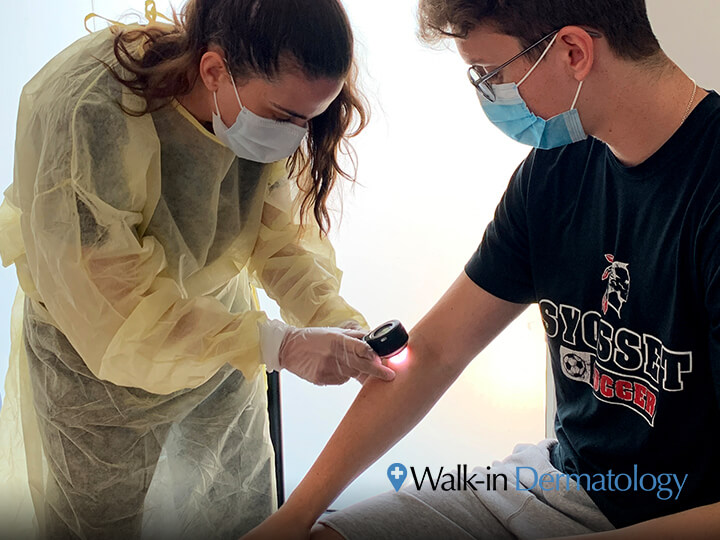Tues: 8:30am - 3:00pm
Wed: 12:00pm - 6:00pm
Thurs: 8:30am - 3:00pm
Fri: Closed
Sat: 8:30am - 12:30pm
Sun: Closed
Greenvale, NY 11548
What is a Full Body Skin Exam?


Many skin conditions are easily identified by people who notice something “different” on their skin. Acne, psoriasis, hives, and rosacea, would be examples of conditions that a person might notice. However, moles, sun spots, and other blemishes that appear on the skin are sometimes dismissed or go completely unnoticed. These should be professionally assessed through a full body skin examination performed by a dermatologist.
So what is a full body skin examination? A full body skin exam identifies suspicious growths or spots that may indicate symptoms of skin cancer. This process is also sometimes called “skin cancer screening” and is essential for detecting and treating skin cancer early on.
A Dermatology Full Body Skin Exam
A full body skin exam, or skin cancer screening, is a visual exam that checks the skin for certain unusual marks which may be signs of skin cancer. Birthmarks, moles, and other suspicious spots that have an unusual color, size, shape, or texture are what dermatologists usually pay most attention to during these screenings.
Skin cancer is the most common type of cancer in the United States, and it occurs in four forms: actinic keratoses, basal cell carcinoma, squamous cell carcinoma, and melanoma. Basal and squamous cell carcinoma are the most common skin cancers, while melanoma is the most deadly. With early detection through regular skin screenings and treatment, these cancers have a high cure rate.
Full body skin examinations are best conducted by a dermatologist, who is trained to identify these spots or growths. While some general practitioners conduct routine skin exams, a doctor may refer you to a dermatologist who can do a more detailed examination. Dermatologists are also more familiar with disorders that affect the skin, hair, nails, and mucous membranes – so they are best at diagnosing and treating skin cancer, acne, psoriasis, rosacea, eczema, and more.
How Can a Full Body Skin Exam Detect Skin Cancer?
When dermatologists conduct a complete check-up, they are mostly concerned with signs of skin cancer, which include:
- Shiny pink, red, pearly white, or translucent bumps
- Painful moles
- Skin marks that ooze, bleed, or get crusty
- Sores that don’t heal
- Sores with irregular borders
- Changes in an existing spot or mole
For signs of melanoma, a dermatologist will look more specifically at the growth. They are trying to find the following “ABCDE” signs:
- Asymmetry: The doctor will draw a line through the middle of the growth. If the mole has an odd shape or the halves do not match, it’s considered asymmetrical. This is one possible warning sign of skin cancer.
- Border: One warning sign of skin cancer is a ragged or scalloped border of a mole, freckle, or spot. Cancer-free growths will usually have smooth, even borders.
- Color: If the color of a growth is uneven or multi-colored, then this may indicate skin cancer. Most non-cancerous growths are a single shade of brown.
- Diameter: Cancerous growths are frequently larger than the size of a pea or a pencil eraser, while benign marks are typically smaller in diameter.
- Evolving: Common, benign growths tend to look the same over time. On the other hand, cancerous growths may change in size, shape, color, or elevation.
When these suspicious growths are identified in a screening, patients usually undergo a test, treatment, and finally a follow-up. The test is usually a biopsy, which is a procedure that removes a tiny sample of the skin. The sample will be examined under a microscope to check for cancer cells. A biopsy can accurately determine if the growth is cancerous as well as the type of cancer.
The appropriate treatment will be prescribed after the biopsy, once your dermatologist determines how aggressive the growth is. Finding and treating the disease early will greatly help in preventing the cancer from spreading.
What Can I Expect During a Full Body Exam?
If you have never had a comprehensive check-up by a dermatologist you can expect the exam to last up to 20 minutes. You may be asked to remove your nail polish, make-up, and anything else covering the skin and nails. You will also be requested to wear your hair loose for the exam.
Your doctor will ask you to remove your clothing and wear an exam gown for the head-to-toe exam. They will check your scalp, ears, toes, fingers, buttocks and genitals for any signs of skin cancer, and use a special magnifying glass with a light to see the marks clearly.
Who Should Get a Full Body Exam?
While everyone should get screened by their doctors, some patients are more at risk than others. Here are some characteristics of patients who should have a dermatologist conduct a regularly recurring skin cancer exam for them:
- Patients with a light skin tone
- Patients with skin that burns or freckles easily
- Patients with a history of blistering sunburns
- Patients with a family history of melanoma
- Patients with a family history of other skin cancers
- Patients with a large number of moles
- Patients who have a history of tanning bed use
- Patients who are frequently exposed to the sun through leisure or occupational activities
- Patients who are a recipient of an organ transplant
Get a Skin Cancer Screening at Walk-in Dermatology
Walk-in Dermatology offers comprehensive skin cancer examinations. Let our board-certified dermatologists examine your skin for any marks that have an unusual size, color, or texture. Aside from skin checks, we also offer other medical and cosmetic dermatology services to help you look your best while living a healthy life. Book an appointment with us today.








